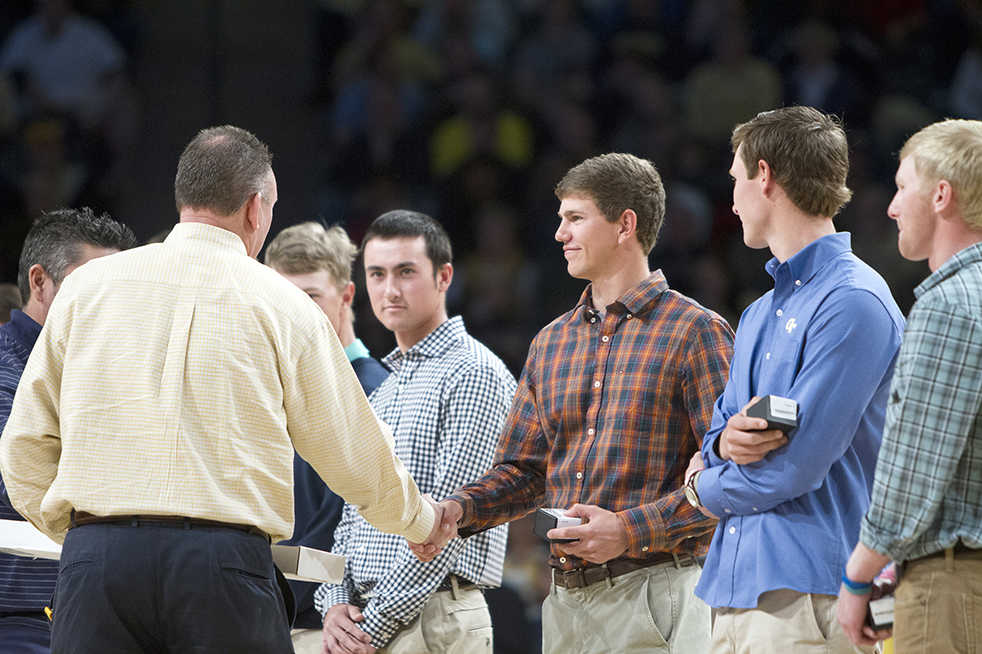With a roster full of fresh faces, the Tech golf team is looking to improve as they tee off in February this spring. With three freshman, four sophomores and only one junior, the Jackets have a bit of room to grow and improve.
Such a new roster can take some time to grow into the collegiate athletic world. Last fall, the Jackets seemed to be finding their place in collegiate golf, but there was some lack of consistency in their competitive performances. The Jackets hope to overcome these growing pains and perform at a consistently high standard in the coming season.
With some notable performances already under his belt, freshman Tyler Joiner of Leesburg, Ga., joined the Jackets’ roster last fall. Joiner was the No. 1 golfer in the state of Georgia and No. 35 on the Junior Golf Scoreboard during his senior year in high school. Representing the Jackets during his first fall at Tech, Joiner finished No. 62 in the Carpet Capital Collegiate Tournament last September and No. 41 in the United States Collegiate Championship last October.
His growth throughout the fall is visible in his improvement from his first to his second tournament as a Jacket. Tech golf fans can look forward to hearing more about Joiner’s growth throughout the spring as he continues to gain collegiate experience.
Growth is going to be the main goal of the spring, not only for Joiner, but for the entire golf team. The Jackets were unable to secure higher than fifth place in their four fall tournaments. By the end of the fall season, Tech had lost its No. 9 spot in the Golfweek rankings. Head coach Bruce Heppler and his assistant Jeff Pierce explained this poor fall performance to Matt Winkeljohn of ramblinwreck.com with some statistical analysis.
Pierce, also new to Tech but well-versed in both golf and statistics, was able to track some inconsistencies in each golfer’s data. Heppler is now requiring that the Jackets pay more attention to the numbers in order to understand their tendencies better and improve any recurring issues they might have.
In most of Tech’s fall tournaments, the Jackets teed off in fine standing and managed to stay ahead for most of the first two rounds. However, it only took one round for the Jackets to lose their footing, and the rest of the tournament was a struggle, a trend that cannot continue.
For players that are more inexperienced with collegiate golf, the debut season can be one of the biggest learning experiences of their collegiate careers. Heppler’s new numerical approach should help Tech’s golfers develop stronger strategies in the spring.
On Feb. 4, the Jackets trade Atlanta’s cool, rainy weather for a weekend of warmth and sunshine in Waikoloa, Hawaii, at the 25th Annual Amer Ari Invitational, held at the Waikoloa Resort. The resort has two luxury courses: the Beach Course and the King’s Course. The invitational hosts many of the top collegiate golf teams, the likes of Auburn, USC, Stanford and, of course, Tech.
Last February, the Jackets performed well at the invitational, moving from a tie at 15th in round one to tied for seventh in the third and final round. Jacket fans have high hopes that Tech will be able to put the growing pains behind them and perform very well in their first invitational of the spring.
The Jackets enter the invitational this year No. 26 in the USA Today Men’s Team Collegiate Rankings. Auburn is ranked first. Stanford comes in at No. 5, and USC tallies in at No. 8. At a high level of competition, any semblance of an advantage can prove decisive, the difference between a successful day on the course and a losing effort. If the team converts its statistical understanding into results, analytics could give Tech the edge.
